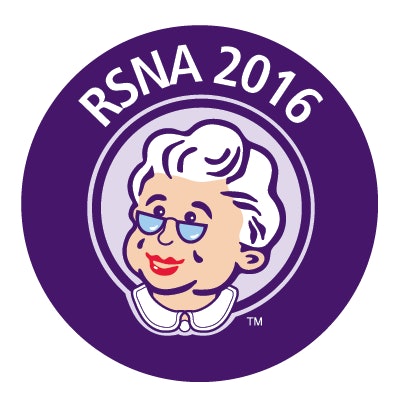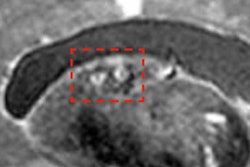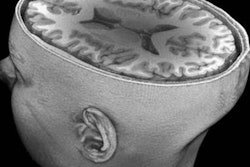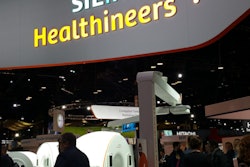
CHICAGO - In a new study, German researchers found that side effects related to a patient's balance after a 7-tesla MRI scan dissipated within minutes, according to results presented on Monday at RSNA 2016.
Most of the effects on a person's vestibular system, which includes the inner ear and brain to help control balance, after exposure to the high-field magnet were gone in less than 15 minutes.
"Seven-tesla MRI causes only a temporary dysfunction or overcompensation of the vestibular system," lead author Dr. Jens Theysohn from University Hospital Essen told RSNA attendees. "We think the expected time to resolve [the issues] is about 30 minutes."
The potential of 7T
The lure of 7-tesla MRI for researchers and clinicians is the modality's increased signal-to-noise ratio and stronger contrast in images. Field strengths of up to 8 tesla are considered to hold no risk for humans, based on international guidelines developed over the years, Theysohn told AuntMinnie.com.
Any aftereffects of MRI, especially with 7-tesla magnets, are primarily due to different components within the scanner. The static magnetic field, for example, is most known for side effects such as vertigo and metallic taste, while the gradient system has been associated with peripheral nerve stimulation.
"We also have had a few subjects when coming out of the scanner tell us they feel a bit unsure on their feet or dizzy," Theysohn said.
Theysohn and colleagues decided to collaborate with the university's neurology department to find a test to quantify vestibular performance before and after different MRI scan scenarios and to compare the effects of 7 tesla and 1.5 tesla.
The researchers enrolled 20 healthy volunteers; the 10 men and 10 women had a mean age of 41 years. All participants underwent both 7-tesla (Magnetom 7T, Siemens Healthineers) and 1.5-tesla (Avanto, Siemens) scans. They had their posture and balance analyzed before the exam, as well as two minutes and 15 minutes after each scan scenario.
Regarding the scan scenarios, the subjects were scanned for 30 minutes with identical turbo spin echo (TSE) and gradient-recalled echo (GRE) sequences. They were also divided into the following subgroups:
- 1.5-tesla MRI with no radiofrequency (RF)
- 7-tesla MRI with no RF
- 7-tesla MRI in which subjects entered the magnet and were removed less than one minute later
- 7-tesla MRI with deactivated RF and deactivated gradient coils
To assess any side effects, the researchers used the Romberg test and Unterberger stepping test. For the Romberg test, volunteers were asked to stand straight on a foam cushion with their feet together and arms lifted. The test was performed with eyes closed and eyes open.
"With eyes open, you can fixate on a point on a wall, and you are not as likely to shift to the side," Theysohn explained. "But if you close your eyes and stand on the foam cushion with feet together, you are more likely to shift to the left and to the right and make more movements trying to hold your balance."
For the Unterberger stepping test, participants were asked to stand in the same position without the foam cushion and to walk in place with their eyes closed. Normally, when people do so, they naturally turn slightly to the left or the right. Data were collected on movements via body sensors.
Small changes
The Romberg test with eyes open showed no change in position of the subjects after 1.5-tesla MRI. When the eyes were closed, there also was very little change in the participants' position. At 7 tesla with eyes closed, the lumbar spine swayed and there were significant changes in shoulder rotation two minutes after leaving the scanner. Both the lumbar spine and shoulders returned to normal after 15 minutes.
"At first we were surprised when we saw this, but then we thought the vestibular organ is compensating for being in the magnet for 15 minutes or longer," Theysohn told attendees.
Meanwhile, the Unterberger stepping test revealed noteworthy changes after 7-tesla exposures. Among the group that was in the high-field magnet for less than one minute, shoulder rotation was more dramatic after two minutes, and better but not quite back to normal by the 15-minute mark. Lumbar spine movements also were more pronounced with this testing method.
"With this test, we seem to have found the temporary change in the vestibular organ that does not normalize after 15 minutes, but later," Theysohn said.
Further analysis found that older subjects experienced more sway of the lumbar spine and shoulder shifting two minutes after 30 minutes of 7-tesla MRI exposure, compared with their younger counterparts. Changes after brief 7-tesla exposure also were greater based on the Unterberger stepping test in the older group.
In conclusion, Theysohn said exposure to the static magnetic 7-tesla field causes only a temporary dysfunction or overcompensation of the vestibular system not measurable at 1.5 tesla. He added that the Unterberger stepping test is more sensitive in detecting vestibular disturbances than the Romberg test.
"The Unterberger stepping test might be most sensitive due to its nature to test rotation in a similar plane," Theysohn told AuntMinnie.com. "The magnetic field might induce subtle currents across the vestibular organ, but this is highly speculative and is my personal opinion."



















